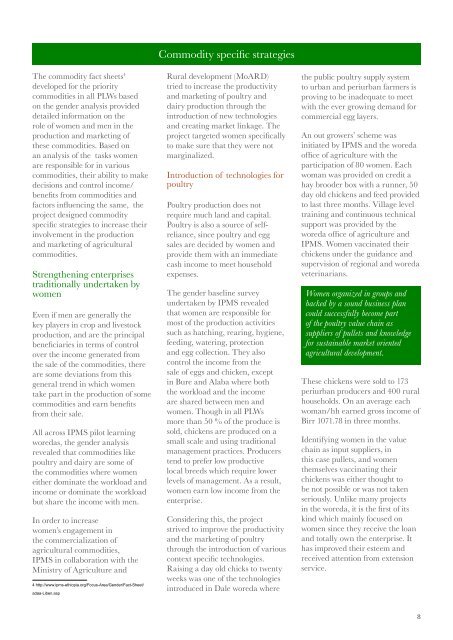Empowering women through value chain development - IPMS ...
Empowering women through value chain development - IPMS ...
Empowering women through value chain development - IPMS ...
Create successful ePaper yourself
Turn your PDF publications into a flip-book with our unique Google optimized e-Paper software.
The commodity fact sheets 4developed for the prioritycommodities in all PLWs basedon the gender analysis provideddetailed information on therole of <strong>women</strong> and men in theproduction and marketing ofthese commodities. Based onan analysis of the tasks <strong>women</strong>are responsible for in variouscommodities, their ability to makedecisions and control income/benefits from commodities andfactors influencing the same, theproject designed commodityspecific strategies to increase theirinvolvement in the productionand marketing of agriculturalcommodities.Strengthening enterprisestraditionally undertaken by<strong>women</strong>Even if men are generally thekey players in crop and livestockproduction, and are the principalbeneficiaries in terms of controlover the income generated fromthe sale of the commodities, thereare some deviations from thisgeneral trend in which <strong>women</strong>take part in the production of somecommodities and earn benefitsfrom their sale.All across <strong>IPMS</strong> pilot learningworedas, the gender analysisrevealed that commodities likepoultry and dairy are some ofthe commodities where <strong>women</strong>either dominate the workload andincome or dominate the workloadbut share the income with men.In order to increase<strong>women</strong>’s engagement inthe commercialization ofagricultural commodities,<strong>IPMS</strong> in collaboration with theMinistry of Agriculture and4 http://www.ipms-ethiopia.org/Focus-Area/Gender/Fact-Sheet/adaa-Liben.aspCommodity specific strategiesRural <strong>development</strong> (MoARD)tried to increase the productivityand marketing of poultry anddairy production <strong>through</strong> theintroduction of new technologiesand creating market linkage. Theproject targeted <strong>women</strong> specificallyto make sure that they were notmarginalized.Introduction of technologies forpoultryPoultry production does notrequire much land and capital.Poultry is also a source of selfreliance,since poultry and eggsales are decided by <strong>women</strong> andprovide them with an immediatecash income to meet householdexpenses.The gender baseline surveyundertaken by <strong>IPMS</strong> revealedthat <strong>women</strong> are responsible formost of the production activitiessuch as hatching, rearing, hygiene,feeding, watering, protectionand egg collection. They alsocontrol the income from thesale of eggs and chicken, exceptin Bure and Alaba where boththe workload and the incomeare shared between men and<strong>women</strong>. Though in all PLWsmore than 50 % of the produce issold, chickens are produced on asmall scale and using traditionalmanagement practices. Producerstend to prefer low productivelocal breeds which require lowerlevels of management. As a result,<strong>women</strong> earn low income from theenterprise.Considering this, the projectstrived to improve the productivityand the marketing of poultry<strong>through</strong> the introduction of variouscontext specific technologies.Raising a day old chicks to twentyweeks was one of the technologiesintroduced in Dale woreda wherethe public poultry supply systemto urban and periurban farmers isproving to be inadequate to meetwith the ever growing demand forcommercial egg layers.An out growers’ scheme wasinitiated by <strong>IPMS</strong> and the woredaoffice of agriculture with theparticipation of 80 <strong>women</strong>. Eachwoman was provided on credit ahay brooder box with a runner, 50day old chickens and feed providedto last three months. Village leveltraining and continuous technicalsupport was provided by theworeda office of agriculture and<strong>IPMS</strong>. Women vaccinated theirchickens under the guidance andsupervision of regional and woredaveterinarians.Women organized in groups andbacked by a sound business plancould successfully become partof the poultry <strong>value</strong> <strong>chain</strong> assuppliers of pullets and knowledgefor sustainable market orientedagricultural <strong>development</strong>.These chickens were sold to 173periurban producers and 400 ruralhouseholds. On an average eachwoman/hh earned gross income ofBirr 1071.78 in three months.Identifying <strong>women</strong> in the <strong>value</strong><strong>chain</strong> as input suppliers, inthis case pullets, and <strong>women</strong>themselves vaccinating theirchickens was either thought tobe not possible or was not takenseriously. Unlike many projectsin the woreda, it is the first of itskind which mainly focused on<strong>women</strong> since they receive the loanand totally own the enterprise. Ithas improved their esteem andreceived attention from extensionservice.8
















